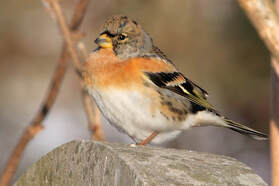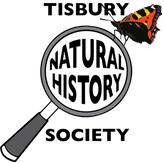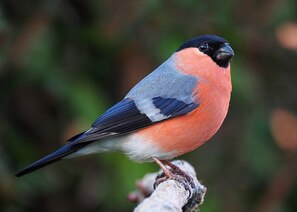 Male brambling. Dunpharlain, CC BY-SA 4.0 , via Wikimedia Commons Male brambling. Dunpharlain, CC BY-SA 4.0 , via Wikimedia Commons Also known as Fringilla Montifringilla. Andrew Graham explains that its scientific name means 'mountain finch' so my thanks to him especially for that. He continues: ' Its name originates from Common West Germanic - brâma meaning bramble or a thorny bush.' This is a bit confusing - perhaps we should call it the 'mountain bramble bird'! 'This attractive bird is a winter visitor, similar in size and shape to the chaffinch. Bramblings are gregarious and often join up with flocks of chaffinches. They have a black head and mantle and orange patches on the breast, shoulder, and throat. Underparts are brown and wings are black with white and orange bars. Females are duller than males [but I think the female on the NewNews page is very pretty - Ed] and juveniles are like females with dark head and grey cheeks. Birds moult after breeding so their plumage is at its freshest in Autumn and Winter. By January, the buff tips on the feathers have been worn off and the breeding plumage so achieved is at its most distinctive. In flight, the bird shows a long white rump, and this is a key to identification, but beware of confusing it with the plumper bullfinch (unlikely to be found in flocks of chaffinches). Bramblings arrive in the UK in autumn with numbers building from September onwards. First arrivals are seen on the east coast, arriving via the continent to avoid long crossings over the North Sea. They then spread inland to all parts of England, Wales, and lower lying parts of Scotland. They will start leaving from Feb to March onwards and all will have returned to their breeding grounds in Scandinavia and north-west Russia by May. One or two pairs occasionally nest in highland Scotland.
Bramblings feed on berries, insects, and seeds but particularly on beech mast. The numbers that arrive here depend upon the amount of mast available in Scandinavia and on the continent. In good mast years relatively few will arrive but if food is scarce or winter weather particularly bad, large numbers may reach us. Perhaps variations in food availability makes brambling migrations unpredictable: birds that winter in the UK one year have been found in Italy the next. Bramblings come into gardens and visit bird tables but usually only during the harshest weather. The best place to look for them is moving through beech woods or on farmland fields nearby. Beechwoods near Compton Abbas airfield and Melbury Wood are promising locations. At this time of year, it is worth checking any flock of finches. On the continent they may form huge flocks, some roosts have been estimated to contain over ten million birds. Comments are closed.
|
Photo: Avocets (Izzy Fry)
The headers display photos taken by our members. Do get in touch via the Contact Form if you'd like to submit a photo for selection.
Archives
May 2024
Categories
All
|


 RSS Feed
RSS Feed